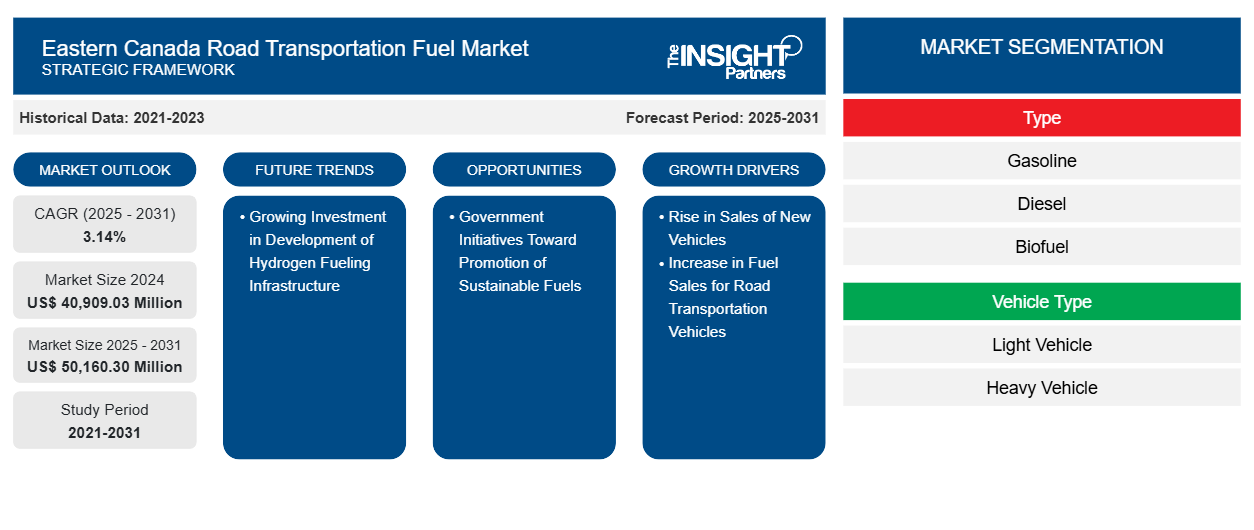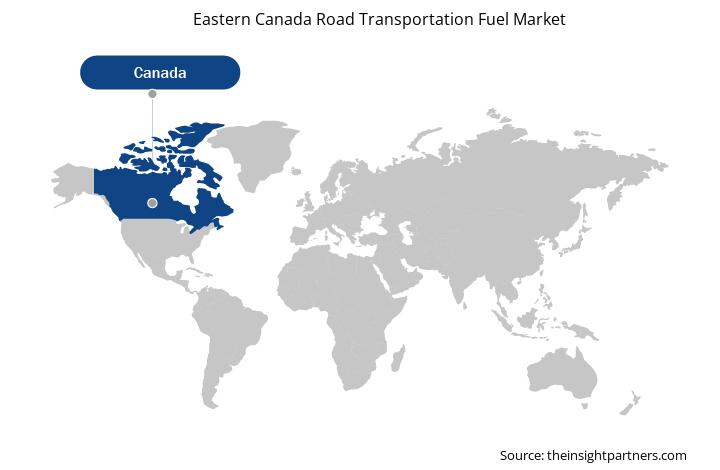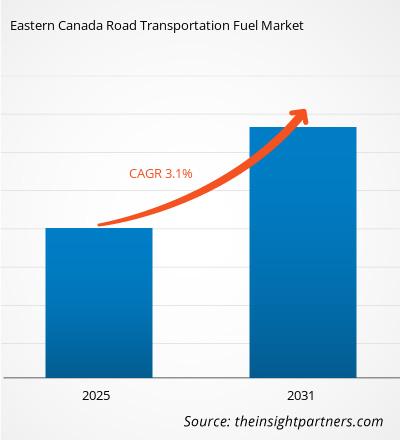预计到2031年,加拿大东部道路运输燃料市场规模将从2024年的409.0903亿美元增至501.6030亿美元。预计2025年至2031年期间,该市场的复合年增长率将达到3.14%。交通运输行业不断增长的投资可能会在未来几年为市场带来新的趋势。
加拿大东部道路运输燃料市场分析
运输燃料在加拿大经济中发挥着重要作用。加拿大东部运输燃料市场生态系统的主要利益相关者包括炼油厂、运输燃料分销商和零售商以及最终用户。主要最终用户包括客运和货运车辆。公路运输分为货物运输和人员运输。运输燃料是驱动各种运输方式中使用的内燃机的能源。运输部门包括用于人员和货物运输的公路(包括汽车、卡车和公共汽车)、铁路、海运和空运。运输部门占能源消耗的近 20%,是加拿大最大的石油消费部门。运输燃料是将提取的能源资源转化为可用产品的炼油过程的产物。液体燃料因主要燃料来源的化学特性而异。目前,超过 80% 的运输燃料来自石油。安大略省和魁北克省对加拿大东部的公路运输燃料市场影响重大,因为这些省份拥有大量的公路运输燃料消费者。
加拿大东部道路运输燃料市场概览
加拿大汽车产销量的增长推动了道路运输燃料市场的增长。此外,道路运输车辆燃料销量的增长也推动了加拿大东部道路运输市场的增长。此外,政府在道路运输应用中推广可持续燃料的举措预计将在2025年至2031年期间推动市场增长。此外,预计在预测期内,对氢燃料基础设施建设的投资不断增长将成为市场的主要趋势。
推动加拿大东部公路运输燃料市场发展的关键行业包括运输和物流、建筑、采矿、石油和天然气、医疗保健和电子商务。根据加拿大燃料协会的统计,每年约有 2 亿升燃料被泵入加拿大各地的车辆油箱。加拿大有 16 座炼油厂、75 个燃料配送终端和超过 12,000 个零售和商业场所。此外,加拿大政府与州政府致力于推广替代或可持续燃料,以实现加拿大未来的燃料结构和能源转型目标。加拿大消费者对大型车辆的偏好日益增加,这对汽油和柴油的需求产生了重大影响,而这反过来预计将推动加拿大市场的增长。
加拿大东部公路运输燃料市场的最终用户包括轻型和重型车辆。这些车辆用于全国各地的客运和货运。预计该地区新车登记量的增加将在未来几年推动公路运输燃料的需求。受物流、电子商务、制造业和建筑业增长的推动,加拿大东部公路运输贸易活动的增加预计将在2025年至2031年期间推动公路运输燃料的需求。
您可以免费定制任何报告,包括本报告的部分内容、国家级分析、Excel 数据包,以及为初创企业和大学提供优惠和折扣
加拿大东部道路运输燃料市场:战略洞察

-
获取此报告的顶级关键市场趋势。此免费样品将包括数据分析,从市场趋势到估计和预测。
加拿大东部道路运输燃料市场驱动因素和机遇
道路运输车辆燃料销量增加
近年来,加拿大卡车燃料销量大幅增长。这一增长可归因于多种因素,这些因素既反映了经济形势,也反映了消费者偏好的变化。它凸显了加拿大运输业的更广泛动态,而运输业在经济中发挥着至关重要的作用。随着加拿大继续从新冠疫情的影响中复苏,经济活动明显回升,导致燃料需求增加。商业活动的恢复,加上消费者出行的增加,导致燃料消耗增加,尤其是汽油和柴油。此外,包括乘用车、卡车和商用车在内的车辆注册量的增加也促进了燃料销量的增长。随着加拿大人出行和经商,道路运输燃料的需求也大幅飙升。
政府推动可持续燃料发展的举措
随着世界各国加大力度,力争在2050年实现净零排放(NZE),碳减排和零排放燃料的生产将迎来重大转变。加拿大将成为这些燃料的生产国和消费国,而这些燃料正是消费者现在和未来日益追求的。《清洁燃料法规》加大了对可持续燃料、技术和工艺的开发和采用的激励力度。《清洁燃料法规》的目标是通过逐步提高清洁燃料的清洁程度,从而显著减少污染。《清洁燃料法规》要求液体化石燃料(汽油和柴油)的供应商逐步降低其在加拿大生产和销售的燃料的碳强度(或污染量)。这意味着到2030年,加拿大使用的汽油和柴油的碳排放强度将降低近15%(低于2016年的水平)。根据国际能源署(IEA)和加拿大先进生物燃料协会的数据,生物柴油的总产量将从2021年的4.31亿升增加到2023年的4.96亿升。此外,生物柴油的消费量也将从2021年的4.12亿升增加到5.25亿升。因此,预计政府推广可持续燃料的举措将在预测期内为加拿大东部公路运输燃料市场的主要参与者创造机会。
加拿大东部道路运输燃料市场报告细分分析
有助于得出加拿大东部道路运输燃料市场分析的关键部分是类型和车辆类型。
- 按类型划分,市场分为 汽油、柴油、生物燃料、天然气和其他燃料。2024年,汽油燃料占据了市场主导地位。
- 根据车辆类型,市场分为轻型车辆和重型车辆。2024年,轻型车辆市场占据主导地位。
加拿大东部道路运输燃料市场份额分析(按地区)
加拿大东部道路运输燃料市场分为四个主要省份:安大略省、魁北克省、沿海省份和其他省份。安大略省在2024年占据市场主导地位,其次是魁北克省和沿海省份。
加拿大统计局的数据显示,2023 年新乘用车注册量从 2021 年的 93,867 辆下降到 67,788 辆。此外,汽油车注册量从 2022 年的 295,288 辆下降到 2024 年的 288,324 辆,柴油车销量从 2022 年的 15,278 辆增加到 2024 年的 15,860 辆。汽油车销量下降的原因在于该地区对零排放汽车的需求不断增长以及政府推出的推广举措。例如,由于魁北克政府加大了推广零排放汽车的力度,该省各类零排放汽车的销量从 2022 年的 45,881 辆增加到 2024 年的 147,507 辆。 2024年12月,魁北克省通过法规,禁止在2035年之前在魁北克省销售所有新的轻型内燃机汽车,实现2035年100%零排放汽车的目标。此外,道路机动车使用的液化石油气(LPG)净销量从2021年的7484万升增加到2023年的1.182亿升。因此,魁北克省道路运输部门燃料消耗的增长预计将推动2025年至2031年的市场增长。
加拿大东部道路运输燃料市场区域洞察
Insight Partners 的分析师已详尽阐述了预测期内影响加拿大东部道路运输燃料市场的区域趋势和因素。本节还讨论了加拿大东部道路运输燃料市场在北美、欧洲、亚太地区、中东和非洲以及南美和中美的细分市场和地理位置。

- 获取加拿大东部道路运输燃料市场的区域具体数据
加拿大东部道路运输燃料市场报告范围
| 报告属性 | 细节 |
|---|---|
| 2024年的市场规模 | 409.0903亿美元 |
| 2031年的市场规模 | 501.603亿美元 |
| 全球复合年增长率(2025-2031) | 3.14% |
| 史料 | 2021-2023 |
| 预测期 | 2025-2031 |
| 涵盖的领域 |
按类型
|
| 覆盖地区和国家 |
加拿大东部
|
| 市场领导者和主要公司简介 |
|
加拿大东部道路运输燃料市场参与者密度:了解其对商业动态的影响
加拿大东部道路运输燃料市场正在快速增长,这得益于终端用户需求的不断增长,而这些需求的驱动因素包括消费者偏好的转变、技术进步以及对产品优势的认知度的提升。随着需求的增长,企业正在扩展产品线,不断创新以满足消费者需求,并抓住新兴趋势,从而进一步推动市场增长。
市场参与者密度是指特定市场或行业内企业或公司的分布情况。它表明特定市场空间内竞争对手(市场参与者)的数量相对于其规模或总市值而言。
在加拿大东部道路运输燃料市场运营的主要公司有:
- 雪佛龙奥伦耐公司
- 森科尔能源公司
- 瓦莱罗能源公司
- Equinor ASA
- 埃克森美孚公司
- 中国海洋石油有限公司
免责声明:以上列出的公司没有按照任何特定顺序排列。

- 获取加拿大东部道路运输燃料市场顶级关键参与者概览
加拿大东部道路运输燃料市场新闻及最新发展
加拿大东部道路运输燃料市场的评估是通过收集一手和二手资料后进行的定性和定量数据进行的,这些资料包括重要的企业出版物、协会数据和数据库。以下列出了加拿大东部道路运输燃料市场的一些关键发展:
- TotalEnergies Marketing Canada Inc. 强调了其与加拿大 Wajax 的战略合作伙伴关系,旨在提供润滑油并提供 TotalEnergies 的全系列产品组合,以满足工业、林业、建筑、采矿、运输和其他领域各种应用的需求。(来源:TotalEnergies Marketing Canada Inc,新闻稿,2024 年 9 月)
- 雪佛龙公司正在探索生产可再生燃料的新途径。该公司正在探索新的碳利用途径,以实现低碳未来。雪佛龙目前正在探索如何利用新型催化剂将捕获的二氧化碳 (CO2) 转化为可持续航空燃料、甲醇和其他低碳强度燃料。(来源:雪佛龙公司,新闻稿,2024 年 8 月)
加拿大东部道路运输燃料市场报告覆盖范围和交付成果
《加拿大东部道路运输燃料市场规模和预测(2021-2031)》对以下领域进行了详细的市场分析:
- 加拿大东部道路运输燃料市场规模以及各省级预测,涵盖范围内的所有主要细分市场
- 加拿大东部公路运输燃料市场趋势,以及驱动因素、限制因素和关键机遇等市场动态
- 详细的 PEST 和 SWOT 分析
- 加拿大东部公路运输燃料市场分析,涵盖主要市场趋势、区域和省份框架、主要参与者、法规和最新市场发展
- 行业格局和竞争分析,涵盖市场集中度、热图分析、知名参与者以及加拿大东部公路运输燃料市场的最新发展
- 详细的公司简介
- 历史分析(2 年)、基准年、预测(7 年)及复合年增长率
- PEST和SWOT分析
- 市场规模、价值/数量 - 全球、区域、国家
- 行业和竞争格局
- Excel 数据集
近期报告
客户评价
购买理由
- 明智的决策
- 了解市场动态
- 竞争分析
- 客户洞察
- 市场预测
- 风险规避
- 战略规划
- 投资论证
- 识别新兴市场
- 优化营销策略
- 提升运营效率
- 顺应监管趋势






















 获取免费样品 - 加拿大东部道路运输燃料市场
获取免费样品 - 加拿大东部道路运输燃料市场